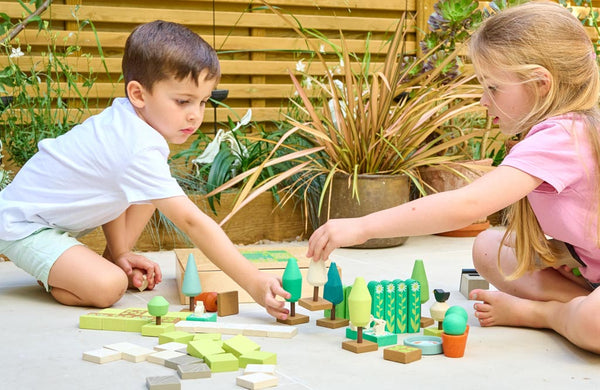Spark your child's curiosity with invitations to play

An invitation to play is just what it sounds like - an enticing set-up of toys or other materials that pique a child’s interest and draw her in.
Search the internet for ‘invitation to play’ and you will see lots of small world activities based around a familiar story.
Here is a scene with three bears, a house and a little girl. What will you make of it?
And that’s fine, as far as it goes. These kinds of set-ups can be fun for a while, but the best invitations to play pose a question.
What will you do with these things?
You have a kitchen roll, a ping-pong ball and some sellotape…
The activity could go in many directions. Our role as parents is not to guide our children to a predetermined outcome but to help them get started.
Like those old Choose Your Own Adventure books, anything is possible.
The trick is to make your invitations inviting.
It could be a sensory bin or craft activity, a toy kitchen or gross motor challenge.
The important thing is that it is open-ended, allowing children to explore and experiment in their own way. This approach encourages creativity, problem-solving, and self-directed learning.
Examples of invitations to play
Here are some examples of invitations to play that parents or educators can set up for children:
- Sensory bin: Fill a wide bowl or tuff spot with various materials, such as dried beans, sand, or mud. How will your child explore? Offer spades, funnels, tongs and other tools. Note: small objects are choking hazards. Do not offer to children at the mouthing stage.
- Play kitchen: Put a selection of real and pretend foods in your play kitchen to ‘cook’. Try dried pasta and beans, beads and wooden blocks.
- Art table: Provide art supplies, such as paint, markers, and paper, and invite children to experiment with color, texture, and form in a self-directed and open-ended way.
- Blocks and small world materials: Offer a variety of blocks, figures and scenery, perhaps with a familiar book as a prompt. It’s easy to retell Goldilocks or the Three Billy Goats with a few figures and a set of blocks. But you child’s imagination might take her in another direction, and that’s OK. Our goal is to get play started. Where it ends is up to your child.
- Nature table: Offer a table with natural materials chosen for their colour, texture and smell. What other interesting materials could you include that would inspire novel play? What would your child do with sticks and pine cones if you added a pot of playdough? What would she do with leaves and stones if you offered crayons?
- Dress-up box: Take your dressing up box and add some pencils and paper. Perhaps you have an old airline, bus or train ticket you could include. Or an expired passport. Who will your child be? Where will she go?
- Loose parts: Present pots of loose parts like beads, buttons or coins alongside materials that invite your child to position or post the pieces. What would your child do with buttons and a metre stick? How would she use ribbon and paper clips?
Final word
Invitations to play can take many different forms, and the key is to provide open-ended and flexible materials. The focus is on the process, not the product.
Your goal is to set your child’s imagination free.







